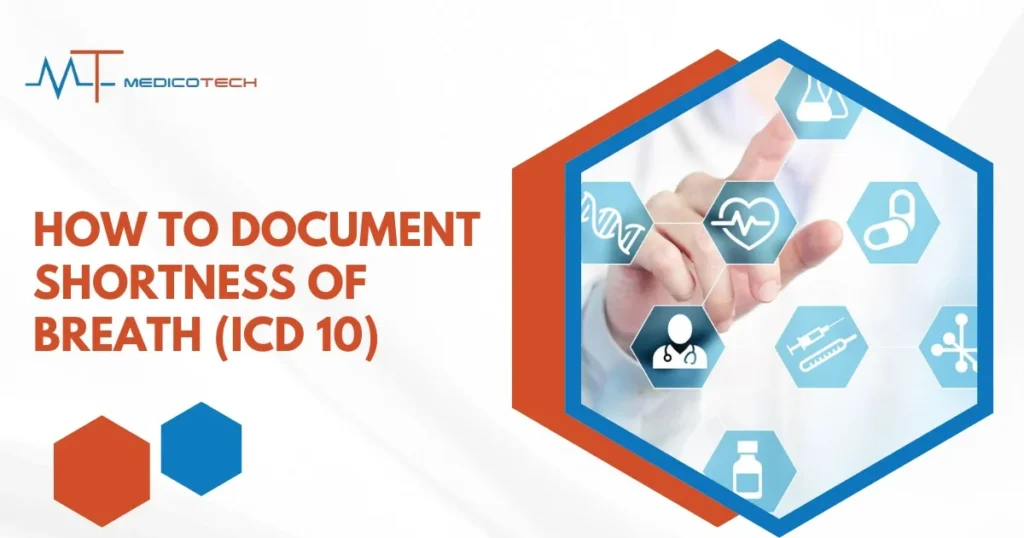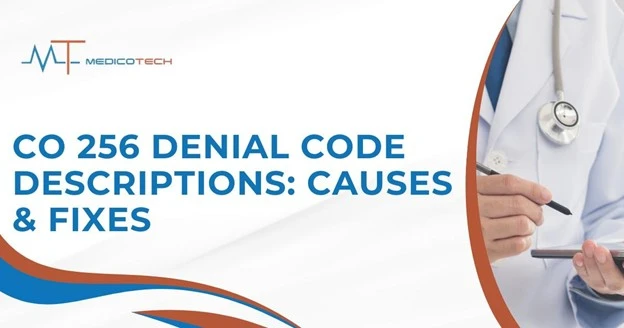Dyspnea or shortness of breath is a frequent and usually painful disease that may manifest itself in many medical conditions. It is defined as the inability to take deep breaths, the feeling of not being able to breathe in a sufficient amount of air. Although sometime shortness of breath might be a simple transitory condition as a result of the physical activity, it may also be a sign of some underlying health conditions that cannot be addressed any further.
Properly recorded shortness of breath is essential in the medical circles in the diagnosis of the condition as well as the provision of reasonable treatment. In addition, both clinical and billing ICD 10 coding must be correct because it is essential to provide insurance companies and healthcare systems with the right diagnosis.
Importance of Correct ICD 10 Coding for Shortness of Breath
The international code of diseases (ICD 10) (10th edition) is a universal code of classifying and coding of all disease and health conditions. Correct ICD 10 coding will enable the healthcare professionals to:
- Communication Precision: This encourages good communication amongst the physicians, specialists and hospitals on the condition of a patient and thus they give them the right care.
- Enforce sound billing: Proper coding makes sure that the healthcare provider is properly reimbursed by the insurance companies on the care that he offers.
- Track the public health trends: With the use of appropriate coding, one can trace the patterns of diseases and the incidence of a particular disease, as well as make appropriate decisions on the public health.
When it comes to shortness of breath, a correct code is used to guarantee that the patient is treated and properly followed up by the healthcare provider and insurers since they know the nature of his condition.
What is Shortness of Breath?
Definition and Symptoms:
Shortness of breath or dyspnea is the feeling that an individual cannot be able to breathe comfortably. The individuals can have this in form of the tightness feeling in the chest area, heavy breathing or the constant need to deeply inhale. Depending on the cause severity can either be mild or severe.
Some symptoms which are common to accompany shortness of breath are:
- Difficulty breathing or feeling unable to take a deep breath.
- Tightness in the chest.
- Wheezing or other abnormal sounds when breathing.
- Fatigue or feeling unusually tired after minimal activity.
Possible Causes and Associated Conditions
The causes of short sightedness of breath may be diverse and may include mild, acute and harmful problems, as well as in serious, long-term disorders. Some common causes include:
- Asthma: A chronic respiratory condition that causes inflammation and narrowing of the airways, leading to wheezing and difficulty breathing.
- Pneumonia: An infection of the lungs that can lead to inflammation and fluid buildup, making it difficult to breathe.
- Heart Conditions: Conditions like heart failure or coronary artery disease can lead to shortness of breath due to the heart’s reduced ability to pump blood effectively.
- Chronic Obstructive Pulmonary Disease (COPD): A group of lung diseases that block airflow and make breathing difficult.
- Pulmonary Embolism: A blood clot that travels to the lungs can cause a sudden onset of shortness of breath, often accompanied by chest pain.
Other causes can include anxiety, obesity, or allergic reactions, among others.
ICD 10 Code for Shortness of Breath: R06.02
Explanation of the ICD 10 code R06.02:
ICD 10 system codes shortness of breath as R06.02, which is the Unspecified Shortness of Breath. This code is applicable in case the cause of the dyspnea is unknown or it is not well known in the medical records of the patient.
The significance of the role of R06.02 is explained by the fact that it includes a generalized diagnostic rule of shortness of breath, and healthcare facilities report the given symptom when they have no appropriate option, or it is still under investigation.
When to Use the ICD 10 Code R06.02
The ICD 10 code R06.02 should be used when:
- The cause of shortness of breath is not immediately identifiable or the diagnosis is not yet confirmed.
- No specific condition has been determined that could explain the symptoms.
- The patient presents with general shortness of breath, which doesn’t directly align with any other specific respiratory or cardiac condition.
It should also be noted that R06.02 is a provisional code and thus it is to be revised as soon as a more specific diagnosis is reached. It represents a guidepost to future research.
Differences Between R06.02 and Other Related Codes
R06.02 is sometimes applied in the general cases of shortness of breath. Nevertheless, healthcare providers can be required to make the diagnosis more specific in case of a detailed diagnosis. These include:
- R06.00: Dyspnea, unspecified (another general code for shortness of breath but with a different classification).
- J45: Asthma, which could be the underlying cause of shortness of breath.
- J18.9: Pneumonia, unspecified organism, if pneumonia is diagnosed.
- I50: Heart failure, a common cause of shortness of breath, especially in elderly patients.
The particular codes assist healthcare providers to record and treat the exact disease resulting in shortness of breath to make more accurate diagnoses and more specific treatment.
Common Causes of Shortness of Breath
Asthma, Pneumonia, Heart Conditions, etc.
- Asthma: Shortness of breath due to narrowing of the airways, often triggered by allergies or exercise.
- Pneumonia: A bacterial or viral infection leading to fluid buildup in the lungs, making it harder to breathe.
- Heart Conditions: Reduced heart function in conditions like heart failure can lead to fluid buildup in the lungs, causing shortness of breath.
- COPD: Chronic obstruction of airflow in the lungs, causing persistent breathlessness, especially during physical activity.
When to Use Specific Diagnosis Codes Instead of R06.02
Although R06.02 is a general code used to explain unspecified shortness of breath, it is necessary to change to a more specific code after the precise cause has been established. For instance:
- If asthma is diagnosed, you would use the code J45.
- If pneumonia is diagnosed, you would use J18.9.
- If a heart condition is causing shortness of breath, you would use I50 for heart failure.
Applying the very codes will make the diagnosis of the patient complete, providing the opportunity of addressing the specific treatments and proper billing.
Documenting Shortness of Breath for Accurate Coding
Shortness of breath or dyspnea is one of the pitfalls that are frequently experienced in the healthcare setting, diagnosis, treatment, and billing cannot take place without proper records being made. The significance of reporting such symptom is not only in proper medication but also the right recording of the patient condition to be coded and principally the ICD 10 billing. Shortness of breath is documented as follows:
How to Properly Document Symptoms
Be Specific: The conditions of the nature of shortness of breath must be spelt out well in the documentation. Is it sudden or gradual? Is it associated with offense or during relaxation? Knowledge of the symptom surrounding aids medical professionals in deciding on the course of action to take.
Describe Severity: It is important to describe how short the breath is, in mild, moderate, severe or patient reported measures such as Borg scale of perceived exertion. This assists in monitoring the improvement or the aggravation of symptoms.
Duration and Onset: Are used to report the number of months the patient has had shortness of breath and their acute or chronic nature. An observation of the time it first occurred and the factors that were mentioned (e.g., exercise, allergies, or underlying conditions) will help to diagnose and prescribe it properly.
Associated Symptoms: Note down any other symptoms that may go hand in hand to be specific like a cough, chest pain, wheezing, or edema since they may be essential in identifying various conditions.
Importance of Detailing Severity and Duration
Properly describing the severity and the duration of dyspnea helps clinicians to make a distinction amongst numerous possible diagnoses. For example:
- Chronic conditions: Such as asthma, chronic obstructive pulmonary disease (COPD), or heart failure, may cause ongoing, intermittent shortness of breath.
- Acute conditions: Conditions like pneumonia or pulmonary embolism can cause sudden, severe breathlessness and may require urgent intervention.
It is also intrinsic and based on severity and duration. The shortness of breath during a short period can be managed by rest and inhalers but a long-lasting and acute instance may necessitate hospitalization and more complex interventions.
ICD 10 Coding for Specific Causes of Shortness of Breath
In recording shortness of breath, it is important to learn how to record its evaluation correctly according to ICD 10 system. Even the shortness of breath falls in R06.02 (Shortness of breath), however, in many cases, the underlying pathology must be specified and coded separately.
Overview of Codes for Asthma, Pneumonia, etc.
Here are some common related ICD 10 codes:
- Asthma: J45 (Asthma), with specific codes for different types of asthma (e.g., J45.40 for moderate persistent asthma).
- Pneumonia: J18 (Pneumonia, unspecified organism) or more specific codes for bacterial or viral pneumonia (e.g., J15.9 for bacterial pneumonia, unspecified).
- Heart failure: I50 (Heart failure), with distinctions for systolic or diastolic failure.
Differences in Coding for Related Conditions
Various causes of shortness of breath will use different codes of icd 10. A particular diagnosis should be mentioned:
- Chronic vs. Acute: Chronic conditions like asthma or COPD will have different codes from acute conditions like pneumonia or a pulmonary embolism.
- Exacerbations: Some conditions, such as asthma, will have codes for exacerbations (e.g., J45.901 for acute exacerbation of asthma) versus stable conditions.
Tips for Proper Billing and Coding of Shortness of Breath
To properly achieve correct billing and to make sure that the situation of the patient is adequately described in order to be reimbursed, the following are the main tips:
Always Use the Most Specific Code Available: For example, when diagnosing asthma, use the specific type and severity code (e.g., J45.40 for moderate persistent asthma) instead of the general J45 code.
Use Secondary Codes for Comorbidities: If the patient has multiple conditions contributing to their shortness of breath (e.g., heart failure and pneumonia), use secondary codes to reflect these comorbidities for accurate billing.
Document the Reason for the Visit: If the patient is seeing the doctor specifically for shortness of breath, make sure this is clearly documented in the medical record to support the coding.
Be Precise About the Date of Onset: Precise documentation of when the symptoms started is crucial for coding, particularly in distinguishing between acute and chronic conditions.
Use Appropriate Modifier Codes: If shortness of breath is secondary to a larger condition, use modifier codes to explain the relationship, such as a Z code for factors influencing health status.
Best Practices for Coders and Healthcare Providers
To ensure accuracy in coding shortness of breath:
Review Documentation Regularly: Healthcare providers and coders should review patient records regularly to ensure that all necessary details are included particularly the severity, duration, and associated symptoms.
Stay Updated on Code Changes: The ICD 10 coding system is updated regularly, so healthcare professionals should stay current on any changes to codes or classifications.
Utilize Coding Software: Using professional coding software can help catch errors, suggest the most accurate codes, and keep track of patient history for recurring conditions like shortness of breath.
Avoiding Common Coding Mistakes
Underdiagnosing the Condition: Always ensure the code for shortness of breath is as specific as possible. Don’t default to using a general code like R06.02 when a more specific condition like asthma or pneumonia is involved.
Incorrectly Assigning Primary vs. Secondary Codes: Always double check which condition is primary and which is secondary. For example, if pneumonia is the primary cause of the shortness of breath, it should be listed as the primary diagnosis.
Failure to Document Co morbidities: When a patient has multiple conditions contributing to their shortness of breath, those conditions need to be documented and coded appropriately. Missing codes for comorbidities could result in lower reimbursement rates.
Inconsistent Documentation: Inconsistent or vague descriptions of the symptoms or the underlying condition can lead to coding errors. Ensure that each encounter provides a thorough and clear explanation of the patient’s symptoms.
Conclusion
Proper documentation and coding of shortness of breath play an important role in returning healthcare providers with the adequate compensations on the kind of care they deliver. The use of the ICD 10 codes is specific and this directly affects patient care, treatment decision and billing accuracy. Never fail to get extensive and precise documentation of the symptoms, its intensity, and conditions.
Coding shortness of breath needs hard work, detail and awareness of the convoluted conditions capable of leading to this symptom. Through proper and sufficient documentation, coders and the medical fraternity can contribute in enhancing patient outcomes, decrease errors, and guarantee equitable reimbursement of provided services.
FAQs
What is the ICD 10 code for shortness of breath?
Ans. The ICD 10 code for shortness of breath is R06.02.
How do I differentiate between acute and chronic shortness of breath?
Ans. Acute shortness of breath is typically sudden in onset and severe, while chronic shortness of breath may develop gradually and persist over a long period, often with underlying conditions like asthma or COPD.
Do I need to code the underlying condition if it’s causing shortness of breath?
Ans. Yes, always code the underlying condition if it’s identifiable, as this can affect the course of treatment and reimbursement. For example, asthma or pneumonia should be coded separately alongside shortness of breath.
What should I document if the shortness of breath is unexplained?
Ans. If the cause is unclear, the general code R06.02 (Shortness of breath) is appropriate, but thorough documentation of any potential causes, symptoms, and the patient’s history is essential for accurate coding and treatment.




